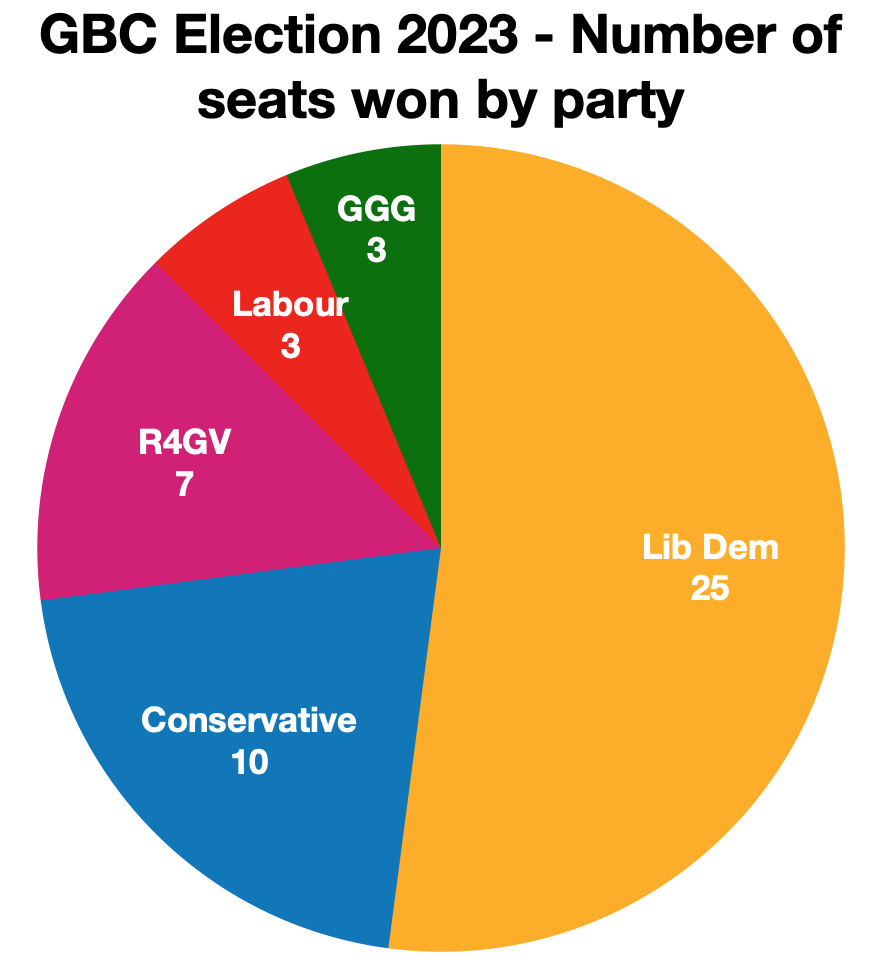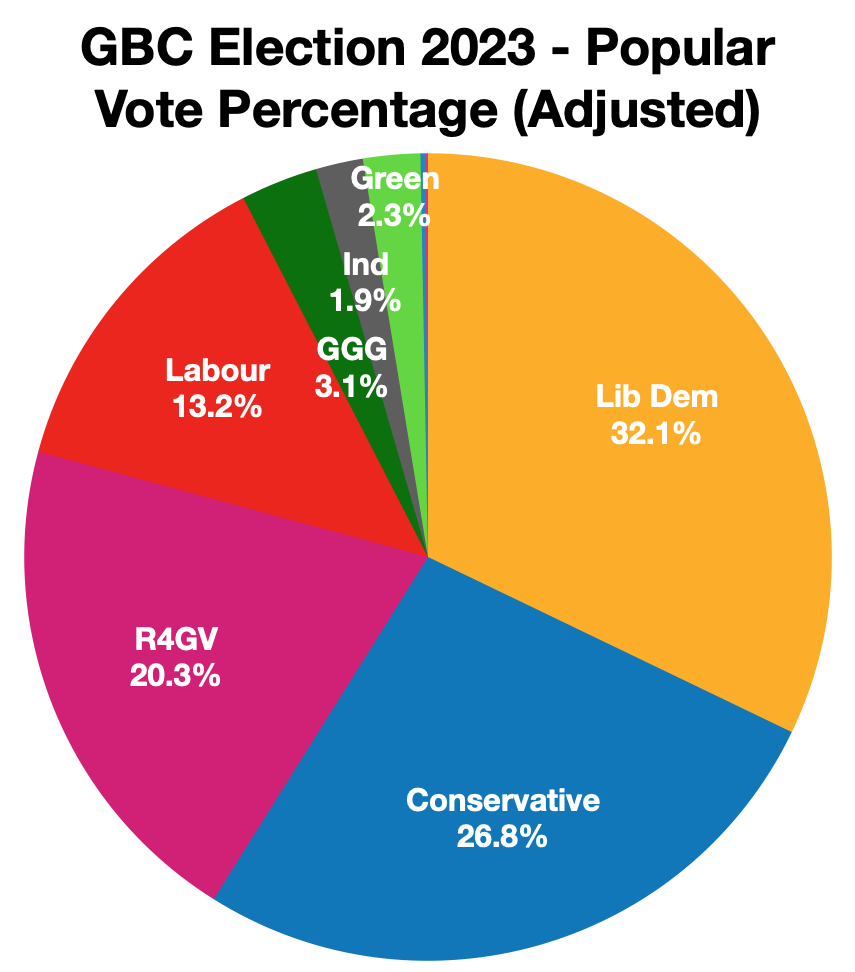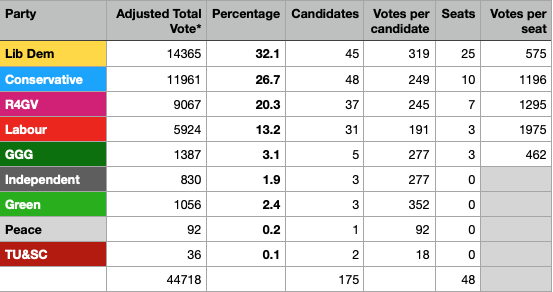 Abraham Lincoln
If given the truth, the people can be depended upon to meet any national crisis...
Abraham Lincoln
If given the truth, the people can be depended upon to meet any national crisis...
 Guildford news...
for Guildford people, brought to you by Guildford reporters - Guildford's own news service
Guildford news...
for Guildford people, brought to you by Guildford reporters - Guildford's own news service
Some Borough Council Election Statistics
Published on: 7 May, 2023
Updated on: 12 May, 2023
The popular vote pie chart and table originally published contained minor errors and have now been corrected.
The headline of the Guildford Borough Council election result is that the Lib Dems won and have taken control of the borough council but it can be interesting to some of us to look a little deeper at the statistics.
GBC has reported that the overall turnout for the borough was 39 per cent. Or put another way six out of every 10 voters in the borough didn’t bother.
The best turnout was in the new single-seat St Nicolas ward, 50.1 per cent, and the worst in the three-seat Westborough ward, 24.5 per cent.
It is noteworthy that half of the 48 elected councillors are female: 16 of them Lib Dem (out of 25); 5 R4GV (out of seven); two Conservative (out of 10) and one Labour (out of three). How might this affect the culture at GBC?
Wikipedia is reporting this summary table to allow comparison of this 2023 result with that of 2019.
 It shows Julia McShane as the leader after the election and although she is the confirmed leader of the largest group, (following we have been told a post-election vote within the Lib Dem group), this will almost certainly be the case but it is subject to a confirmatory vote by the full council. Traditionally no other candidates are put forward where a party has won a majority.
It shows Julia McShane as the leader after the election and although she is the confirmed leader of the largest group, (following we have been told a post-election vote within the Lib Dem group), this will almost certainly be the case but it is subject to a confirmatory vote by the full council. Traditionally no other candidates are put forward where a party has won a majority.
 The popular vote shows that while the Lib Dems won over 50 per cent of the seats they only won a fraction over 30 per of the popular vote, not even a third. To allow for the fact that some voters cast two or three votes in their wards only the votes of candidates with the highest total for their party in each ward were used when compiling the pie-chart and table below.
The popular vote shows that while the Lib Dems won over 50 per cent of the seats they only won a fraction over 30 per of the popular vote, not even a third. To allow for the fact that some voters cast two or three votes in their wards only the votes of candidates with the highest total for their party in each ward were used when compiling the pie-chart and table below.
 If council seats were distributed proportionally there would still be no overall control but, of course, this is academic while the first past the post system remains and different sytems of PR (proportional representation) would give different allocations.
If council seats were distributed proportionally there would still be no overall control but, of course, this is academic while the first past the post system remains and different sytems of PR (proportional representation) would give different allocations.
The postal vote turnout for the borough was 67 per cent, ie 67 per cent or 22,449 of the 33,506 postal ballot papers issued by GBC were returned. We hope to get more information on what percentage of the voters use postal voting. Please check back.
Other statistical information will be added as received.
Responses to Some Borough Council Election Statistics
Leave a Comment Cancel replyPlease see our comments policy. All comments are moderated and may take time to appear.
Recent Articles
- Guildford Institute’s Crowdfunding Project for Accessible Toilet in its New Community and Wellbeing Centre
- Letter: Guildford – Another Opportunity Missed?
- Letter: GBC’s Corporate Strategy – Where Is the Ambition?
- My Memories of John Mayall at a Ground-breaking Gig in Guildford Nearly Six Decades Ago
- Westborough HMO Plans ‘Losing the Heart of the Street’ Says Resident
- College Invests to Boost Surrey’s Economy and Close Digital Skills Gap
- Community Lottery Brings Big Wins for Local Charities
- GBC Housing Plan Promises ‘A Vibrant Urban Neighbourhood’ Near Town Centre
- Hospital Pillows ‘Shortage’ at the Royal Surrey
- Updated: Caravans Set Up Camp at Ash Manor School


Recent Comments
- Ian Macpherson on Updated: Main Guildford to Godalming Road Closed Until August 1
- Sara Tokunaga on GBC Housing Plan Promises ‘A Vibrant Urban Neighbourhood’ Near Town Centre
- Michael Courtnage on Daily Mail Online Reports Guildford Has Highest-paid Council Officer
- Alan Judge on GBC Housing Plan Promises ‘A Vibrant Urban Neighbourhood’ Near Town Centre
- John Perkins on GBC Housing Plan Promises ‘A Vibrant Urban Neighbourhood’ Near Town Centre
- S Collins on GBC Housing Plan Promises ‘A Vibrant Urban Neighbourhood’ Near Town Centre
Search in Site
Media Gallery
Dragon Interview: Local Artist Leaves Her Mark At One of England’s Most Historic Buildings
January 21, 2023 / No Comment / Read MoreDragon Interview: Lib Dem Planning Chair: ‘Current Policy Doesn’t Work for Local People’
January 19, 2023 / No Comment / Read MoreA3 Tunnel in Guildford ‘Necessary’ for New Homes, Says Guildford’s MP
January 10, 2023 / No Comment / Read More‘Madness’ for London Road Scheme to Go Ahead Against ‘Huge Opposition’, Says SCC Leader
January 6, 2023 / No Comment / Read MoreCouncillor’s Son Starts Campaign for More Consultation on North Street Plan
December 30, 2022 / No Comment / Read MoreCounty Council Climbs Down Over London Road Works – Further ‘Engagement’ Period Announced
December 14, 2022 / No Comment / Read MoreDragon Interview: GBC Reaction to the Government’s Expected Decision to Relax Housing Targets
December 7, 2022 / No Comment / Read MoreHow Can Our Town Centre Businesses Recover? Watch the Shop Front Debate
May 18, 2020 / No Comment / Read More











S Page
May 9, 2023 at 9:38 am
“GBC has reported that the overall turnout for the borough was 39 per cent. Or put another way six out of every 10 voters in the borough didn’t bother.”
This is a shocking and deeply saddening figure. What were those seeking election doing to produce such a low figure?
It is disappointing because people will complain that the borough council does not listen to them, but if you don’t vote…
The majority in the council should also take note that they do not have a mandate from the majority of borough residents. All they have is a majority of seats and almost one-third of the popular vote from those who bothered.
Democracy in action? Or democracy inaction?
D Struthers
May 11, 2023 at 8:06 am
Does S Page think the government should also take this stance, given that while the Conservatives won a “landslide” victory in 2019, and obtaining a clear majority of MPs, over half of the voters voted for centre or left-wing parties (as they almost always have in the post-war period, despite the Conservatives having spent most of the period in power)?
I don’t find it at all surprising but I’ve seen and heard plenty, the vast majority clearly Conservative voters, making the argument that other parties winning like this is somehow not good enough, that it doesn’t give them a “mandate”, which seems grossly hypocritical to me – particularly where the winners are the Lib Dems or another party that supports proportional representation.
When it comes to the low turnout in local elections, this is again nothing new or surprising. The two main parties, and particularly the Conservatives, have overseen both massive levels of centralisation and sweeping cuts to local government which has seriously undermined it.
I’m sure it doesn’t help that the media always focus on the low turnout and do so in a manner that I’m sure leads many to think that there isn’t any point voting.